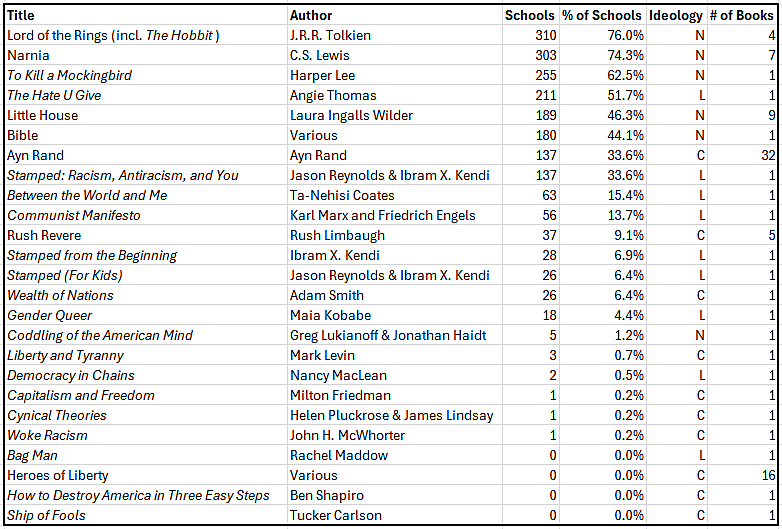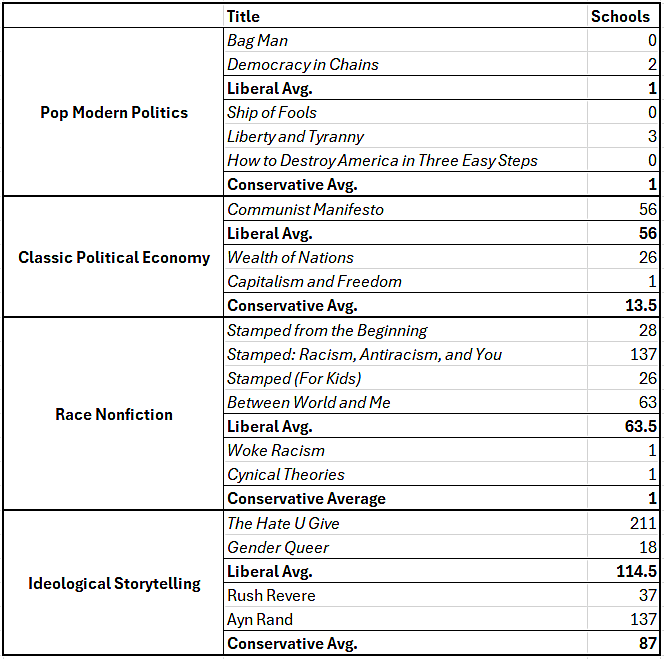"Book “banning” battles continue in public schools, and while more attention has been paid to what books public school libraries stock to begin with since Cato’s Center for Educational Freedom published our October analysis of viewpoint balance, what books libraries acquire has still received scant attention relative to book removals. This prompted us to search for more titles using our nationally representative, random sample of school districts.
The Data
We looked for twenty‐five titles and book collections, the latter including particular authors or series. In theory, this encompassed ninety‐seven titles, but as soon as we found one title from a series or author we ceased searching for others. We sampled 200 traditional districts—no charters or specialty districts—with a focus on middle and high schools, yielding 408 schools that included at least one grade six through twelve.
If a district had multiple schools at different levels, we selected one in each. We conducted searches for some titles at different times, and some library catalogs were or were not publicly accessible at those times. Final numbers are typically not out of 408 schools, but how many schools were searched will vary somewhat by title or series.
The table below shows the titles and series we searched for, including several books by libertarian author Ayn Rand, whose most popular titles are The Fountainhead and Atlas Shrugged. I classified all books or series as liberal, neutral, or conservative, based on my judgment of how the “average” reader would likely identify them. This includes classifying the libertarian Rand offerings as “conservative.”
Overall Results
The most readily available books tend to be classic fiction, including the Lord of the Rings and Narnia fantasy series, and To Kill a Mockingbird. Also among the top titles is The Hate U Give, a newer book (published in 2017) about an African‐American girl from a black neighborhood who goes to a predominantly white prep school and is torn when a neighborhood friend is killed in a police shooting that touches off mass demonstrations and unrest.
In addition to fiction, we included several nonfiction books dealing with political and social issues from diverse ideological perspectives. These include books of a distinctly popular, political nature, largely written by hosts of political television or radio programs, as well as historian Nancy MacLean’s Democracy in Chains: The Deep History of the Radical Right’s Stealth Plan for America.
As seen in the chart below, we found that public school libraries were more likely to carry liberal than conservative books, with liberal books accessible in an average of about sixty schools and conservative in twenty‐one. Neutral books, such as fantasy, dominated both, carried in an average of 207 libraries.
Importantly, given our sample size, we cannot be very confident that the difference between liberal and conservative books captures a true imbalance. Indeed, even with our larger sample of titles than our previous work, relative to all books ever published ours is a small sample and all of our findings should be interpreted with caution. Still, the result is concerning if public school libraries are supposed to offer a wide array of opinions, as the Supreme Court has suggested.

Pairings
To dig a bit deeper, I paired political books by “genre.” The table below shows which books I placed in each category, and the graph below displays the average holdings by ideological leaning for each pairing.

The first finding of note is that school libraries almost never carry “pop modern politics” books, dominated by talk‐show host authors. Both conservative and liberal titles in this grouping were, on average, in just one school.
The next closest split is in “ideological storytelling”—narratives that comment on American society from a particular ideological perspective. These books are not only fiction—Gender Queer is autobiographical, and some Rand books are nonfiction—but the books tend to be in the form of stories. Liberal books in this group tend to be accessible in more schools than conservative, with averages of about 115 and 87 schools, respectively.
Given the sample size, this might not indicate an actual difference nationally. On the flip side, the five‐book Rush Revere series and the thirty‐two‐book Rand collection increase the chances of finding a conservative book, so the relative likelihood of finding a conservative book is possibly overstated.
One other note from this paring: The national debate might overstate the presence of one of the liberal books. Gender Queer, a graphic novel about the nonbinary author’s coming of age, was found in only 18 libraries. Still, it has been the top‐challenged book in public libraries for several years.
The third closest ideological pairing is “classic political economy,” including Marx’s historically crucial The Communist Manifesto and Adam Smith’s classic free‐market work, The Wealth of Nations. The former is much shorter than the latter and might therefore be more accessible, so we paired Communist Manifesto with a highly readable, arguably modern free‐market classic, Milton Friedman’s Capitalism and Freedom. Here again, the liberal side predominates, with the Manifesto found in fifty‐six schools while the conservative counterpoints were, on average, in fewer than fourteen. The higher performer of the conservative books—The Wealth of Nations—is accessible in less than half the number of schools as the Manifesto, and Friedman’s work is in only one school.
Finally, “race nonfiction” consists of discussion of systemic racism in American society. This is what we analyzed in our October paper, but we moved Rush Revere to a different category this time. This is also where we find the biggest imbalance, with books positing that systemic racism is a major problem accessible, on average, in about sixty‐five schools, versus just one school for each book critiquing such thought.
Conclusion
This larger sample of books adds more weight to what our October analysis suggested: There is a left‐leaning imbalance in public school library collections. But it does not establish why that might be. Biased librarians? Book reviewers? Better marketing for liberal books?
We plan to look deeper into the possible drivers of collection imbalance. Still, the overall findings suggest that public school libraries tend to give students access to a slanted field of opinions. That is a problem when everyone must fund these schools."
Friday, May 17, 2024
More Books, More Evidence of Leftward Bias in Public School Libraries
Subscribe to:
Post Comments (Atom)


No comments:
Post a Comment
Note: Only a member of this blog may post a comment.